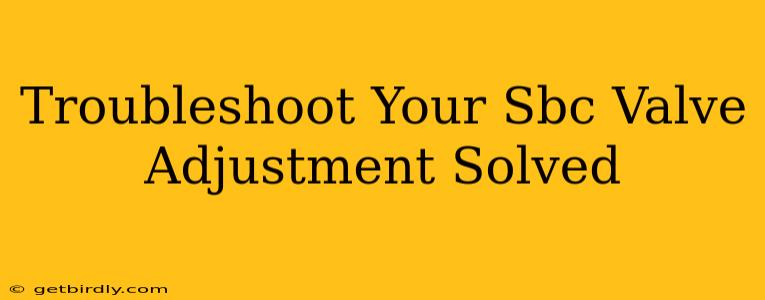Troubleshoot Your SBC: Valve Adjustment Solved
Small-block Chevys (SBCs) are legendary for their power and reliability, but even these workhorses require regular maintenance. One common issue that can lead to performance problems and even engine damage is improper valve adjustment. This article will guide you through troubleshooting your SBC and show you how to perform a proper valve adjustment, restoring your engine to peak performance.
Why is Valve Adjustment Important?
Before we dive into the how-to, let's understand why valve adjustment is crucial. The valves in your engine control the flow of fuel and air into the combustion chamber and exhaust gases out. They rely on precisely calibrated clearances (lash) between the valve stem and the rocker arm. If these clearances are off, several problems can arise:
- Reduced Power: Incorrect valve lash can prevent the valves from fully opening or closing, hindering the engine's breathing and significantly impacting power output.
- Burned Valves: Too little clearance can lead to valves staying open too long, causing them to overheat and burn.
- Bent Pushrods: Excessive clearance can lead to excessive play, potentially bending pushrods and damaging other components.
- Premature Wear: Improper adjustment accelerates wear on the valve train components, leading to more frequent and costly repairs down the line.
Signs Your SBC Needs a Valve Adjustment
Several symptoms indicate that your SBC's valves need adjusting. These include:
- Loss of Power: Noticeable decrease in engine performance, especially at higher RPMs.
- Ticking or Knocking Noise: A rhythmic ticking or knocking sound from the engine, particularly noticeable at idle. This is a classic indicator of valve train issues.
- Rough Idle: The engine runs unevenly and shakes excessively at idle.
- Backfiring: The engine backfires through the carburetor or exhaust.
How to Check Valve Lash on Your SBC
Checking valve lash is the first step to determining if an adjustment is necessary. You'll need a few tools:
- Valve Lash Feelers: A set of feeler gauges with various thicknesses, matching the specifications for your specific SBC engine (consult your owner's manual).
- Socket Wrench Set: To remove the valve covers.
- Torque Wrench: For re-torquing the valve cover bolts.
- A Helper (Recommended): Having someone help makes this process significantly easier.
Procedure:
- Warm-up the engine: Run the engine to operating temperature. This helps ensure consistent measurements.
- Remove the valve covers: Carefully remove the valve covers, paying attention to gasket placement for reinstallation.
- Locate the rocker arms: Identify the intake and exhaust rocker arms for each cylinder.
- Measure the lash: Insert a feeler gauge between the valve stem and the rocker arm. The correct lash varies depending on the year and model of your SBC; check your owner's manual for the specific specifications. If the feeler gauge slides easily, the clearance is too much. If it's too tight, the clearance is insufficient.
How to Adjust Valves on Your SBC
Once you've confirmed that valves need adjustment, follow these steps:
- Loosen the rocker arm adjusting nut: Use the appropriate wrench to loosen the nut on the rocker arm adjusting screw.
- Adjust the lash: Using the feeler gauge as a guide, tighten the adjusting nut until the feeler gauge offers the correct amount of resistance.
- Tighten the locknut: Once the correct lash is set, tighten the locknut to secure the adjustment.
- Repeat for all valves: Repeat steps 1-3 for all intake and exhaust valves.
- Reinstall the valve covers: Carefully reinstall the valve covers and torque the bolts to the manufacturer's specifications.
What if I Don't Know My Engine's Specifications?
Finding the correct valve lash specifications is vital for a successful adjustment. If you don't have the owner's manual, several resources can help:
- Online forums: Dedicated SBC forums can offer specific information based on your engine's year, model, and modifications.
- Repair manuals: Comprehensive repair manuals provide detailed specifications for various SBC engines.
Can I DIY a Valve Adjustment?
While a valve adjustment is a manageable DIY project for mechanically inclined individuals, it requires patience and attention to detail. If you're not comfortable working on your engine, it's best to take your SBC to a qualified mechanic. Incorrect adjustments can lead to significant engine damage.
How Often Should I Adjust My SBC's Valves?
The frequency of valve adjustments depends on several factors, including engine wear, driving style, and the type of camshaft. However, it's generally recommended to check valve lash every 30,000 to 50,000 miles or as recommended by your owner's manual.
By following these steps, you can effectively troubleshoot and adjust your SBC's valves, restoring your engine to optimal performance. Remember, safety is paramount; always consult your owner's manual and exercise caution when working on your vehicle.

